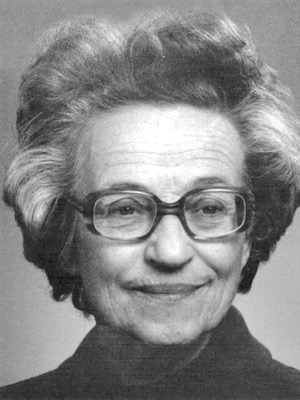Lisa Welander
Lisa Welander (1909 – 2001) was a Swedish neurologist.
Welander was Sweden’s first professor of neurology.
She is eponymously remembered for Welander distal myopathy (1951) and her work with Erik Klas Henrik Kugelberg (1913-1983) to define (Wohlfart-) Kugelberg-Welander syndrome; a hereditary motor neuropathy.
Biography
- 1909 – Born 9 August in Södermanland, Sweden
- 1928 – Karolinska Institute, Stockholm
- 1951 – MD thesis: ‘Myopathia distalis tarda hereditaria: 249 examined cases in 72 pedigrees’
- 1952 – Lecturer in Neurology, Karolinska Institute
- 1953 – Lecturer in Neurology, Gothenburg
- 1964 – Professor of Neurology at Umeå University; head of the Department of Neurology at Umeå University Hospital. Continued in these roles until retirement in 1975
- 2001 – Died 9 December
Medical Eponyms
Welander distal myopathy (1951)
[Also known as: Gowers-Welander syndrome; Gowers syndrome]
A type of muscular dystrophy most often observed in Sweden. Associated with paresis and atrophy of the extensor and small muscles of the distal portion of the extremities and spreads proximally. The condition presents with weakness and clumsiness of the hands, usually in patients aged 40-60, but has also been reported in children. Aetiology unknown.
Welander investigated a group of patients from an area in Gästrikland in the 1940’s. The patients suffered from reduced muscle function in their hands and feet. Welander described the disease and its mode of inheritance in her doctoral dissertation ‘Myopathia distalis tarda hereditaria‘ in 1951. The disorder had a late onset and the muscle histopathology was of myopathic type. The typical distribution of muscle wasting and weakness was distal, but Lisa Welander also described atypical cases with proximal muscle weakness and in some cases a scapular raising phenomenon.
Wohlfart-Kugelberg-Welander syndrome (1956)
[Also known as: Kugelberg–Welander disease]
Erik Klas Henrik Kugelberg (1913-1983) and Welander described a hereditary juvenile spinal muscular atrophy, characterised by slowly progressive muscular weakness. They distinguished it from Werdnig-Hoffman disease, and found it to be due to degeneration of anterior horn cells. Onset is between the ages of 2 and 17 years with survival into middle age or later. It has associated gene maps to chromosome 5 (5q11.2). Manifests as progressive symmetrical, mainly proximal weakness with fasciculations, ophthalmoplegia and eventually kyphoscoliosis, cardiomyopathy, and contractures. It is without sensory signs.
Kugelberg and Welander described 12 cases of this syndrome with onset of weakness from ages 2–17. Pedigrees showed a recessive heredity, the clinical findings were muscle atrophy predominantly in the thighs and flexors of the forearms. Muscle biopsies showed neurogenic abnormalities. Original reports in 1949, 1952 and 1955.
Major Publications
- Welander L. Hereditär handmuskelatrofi. Nordisk Medicin, 1945, 26: 1019.
- Welander L. Myopathia distalis tarda hereditaria; 249 examined cases in 72 pedigrees. Acta Medica Scandinavica. Supplementum. 1951; 265:1-124. [Welander distal myopathy]
- Welander L. Aussprache zu H. Becker: Zur Klinik der Myopathien. Deutsche Zeitschrift für Nervenheilkunde. 1955; 173: 480–481
- Kugelberg E, Welander L. Heredofamilial juvenile muscular atrophy simulating muscular dystrophy. AMA Arch Neurol Psychiatry. 1956;75(5):500-509.
- Welander L. Homozygous appearance of distal myopathy. Acta Genet Stat Med. 1957;7(2):321-325.
References
Biography
- Lisa Welander(1909-2001). Orion Pharma Neurologi. 2003; 16(1): 1
- Borg K, Joélius B. Lisa Welander and Eric Kugelberg–two Swedish myologists in the footsteps of Edward Meryon. The Edward Meryon lecture, the Meryon Society, Oxford 2003. Neuromuscul Disord. 2004;14(6):383-386
- Thomas E, Aziz-Donnelly A, Garcia-Santibanez R. Women in the History of Neuromuscular Medicine. Neuromuscular Disorders. 2019; 29: 698-703
- Bibliography. Welander, L. WorldCat Identities
Eponymous terms
- Gowers WR. A Lecture on Myopathy and a Distal Form. BMJ 1902; 2: 89–92.
- Wohlfart G. Zwei Fälle von Dystrophia musculorum progressiva mit fibrillären Zuckungen und atypischem Muskelbefund. Deutsche Zeitschrift für Nervenheilkunde, 1942; 153(5-6): 189-204.
- Kugelberg E. Electromyography in muscular dystrophies; differentiation between dystrophies and chronic lower motor neurone lesions. J Neurol Neurosurg Psychiatry. 1949;12(2):129-136.
- Preliminary report: Familial Neurogenic (Spinal?) Muscular Atrophy Simulating Ordinary Proximal Dystrophy. 12th Congress of Scandinavian Neurologists, Oslo, Sept. 12,1952
- Wohlfart G, Fex J, Eliasson S. Hereditary proximal spinal muscular atrophy: a clinical entity stimulating progressive myscular dystrophy. Acta Psychiatrica et Neurologica Scandinavica 1955; 30: 395-406.
- Borg K, Ahlberg G, Anvret M, Edström L. Welander distal myopathy–an overview. Neuromuscul Disord. 1998;8(2):115-118.
Graduated from Cardiff Medical School in 2017 with MBBCh and BSc in Psychology and Medicine. Currently working as a doctor in the emergency department at Sir Charles Gairdner Hospital in Perth, Australia.
Studied at University of Birmingham MBChB, and King's College London BSc (Psychology). British doctor working in Emergency Medicine, Perth. Special interests include elderly care, neurology and emergency medicine.



